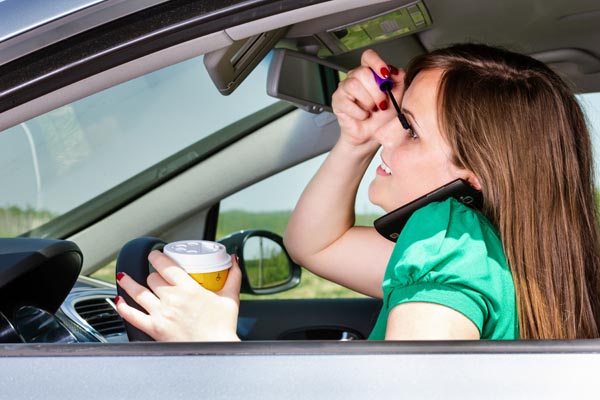In 2014, there were 3,179 motor vehicle fatalities related to distracted driving, and another 431,000 Americans who were injured in collisions where distracted driving was a factor, according to the National Highway Traffic Safety Administration (NHTSA). Data shared also reveal that texting and smartphone use while driving has increased from 1.7 percent of drivers in 2013 to more than 2.5 percent of drivers in 2014 among young drivers aged 16-24 years.
Despite the focus on teen drivers, distracted driving is a problem among all age groups, per data collected by the NHTSA. Drivers in their twenties represented 23 percent of all drivers involved in fatal crashes. Of that number, 27 percent of collisions were caused by distracted drivers who were using mobile phones, despite increased restrictions of graduated licensing designed to increase road time and experience for young drivers, helping them make better choices behind the wheel.

Driver Inexperience Contributes to Distracted Driving
What we love about the spirit and undeniable bravery of teenagers also places them at risk for poor decisions when behind the wheel of a motor vehicle. Many young drivers have never been involved, as a passenger or driver, in a motor vehicle collision. Unfortunately, the optimism and excitement that teen drivers experience is cut short when they are involved in their first accident.
Reaction time and weather conditions are two factors that take experience and years of driving to master. Even the most experienced drivers can easily become distracted by stimuli inside the vehicle (phones, music, or passengers), or by external visuals, including other motor vehicle collisions. It can happen to anyone (which is an important safety message), but when it happens to teens, they have fewer evasive or defensive driving skills to use to avoid a collision.
We know that teens also learn safe driving habits from their parents, and a spokesperson and safe driving educator interviewed on Nightline (ABC News) indicated that in her speaking engagements, most teens admit that their parents also engage in texting and other high-risk habits while driving. This is an important message to parents; model the safe driving habits you want your teens to emulate, and we can all improve road safety. No amount of formal driver’s education can replace the message parents provide about the importance of safe driving.
Why Are Teens More at Risk for Collisions Where Distracted Driving Is a Factor?
Distracted driving involves any activity that takes the driver’s focus off the road. While many teens believe that texting is the primary risk associated with distracted driving, many seemingly harmless activities have an equal impact, and increase the risk of a moderate to serious motor vehicle collision and injury. This is an important educational aspect that parents should address with teen drivers.
Some of the activities that teens may engage in, which place them at increased risk, include:
- Eating and drinking while driving (spills and unwrapping food while driving).
- Talking to other passengers. While graduated licensing limits the number of passengers that a novice driver can have (and the age of the passengers permitted in the vehicle), in-depth conversations can substantially decrease a driver’s attention and focus.
- Grooming hair, make-up application, using napkins, or searching for items in a purse or bag while driving.
- Changing the radio station or CD player, or switching songs via MP3 from a smartphone. These are detailed activities that take eyes off the road and endanger teens.
- Using digital maps or built-in navigation systems for directions.
- Watching a video on a phone or engaging in social media posts, recording videos, or taking pictures while driving.
The activities that are most common, per research studies and surveys, are navigational use, changing music, and texting in a vehicle. It is important for teens to be educated on the impact of reaction time that each of the high-risk activities present, whether driving at a slower speed on streets or on a highway.
The best approach to take regarding distracted driving is to explain how fast an accident can happen. Surveys with young drivers have indicated that, if weather conditions are favorable, teens are overconfident in their ability to brake, steer, and conduct evasive maneuvers to avoid an accident. However, a driver cannot avoid a threat or pending accident if they do not see it coming.
Training Your Teen to be a Safe Driver
Have a serious conversation about driver safety that will resonate with your teen. Many parents have used videos on YouTube to not just tell but to show teens the consequences of distracted driving. Like many things, pictures (while upsetting) or stories of teens who have lifelong disabilities due to a motor vehicle accident are some of the most powerful, lasting impressions you can make.
Talking about responsible driving should not be taken with a punitive approach, or similar to something your parents told you – “crash my car and you’re in big trouble.” Today, teens are just as interested in protecting themselves and the lives of their friends and family members, as they are to taste the freedom that comes with driving a car (without parents). However, they will have an easier time understanding the consequences if they see them first hand.
We found three powerful safety videos on YouTube that parents can use to discuss distracted driving with their teens:
- Caught on Tape: Teen Drivers Moments Before a Crash: Nightline via ABC News
- AAA: Distracted Driving a Serious Teen Problem
- BMW Teen Driving – Highlighting the dangers of distracted driving
Another educational resource that parents can consider using is the “It Can Wait” campaign by AT&T. The website is full of training resources, statistics, and teen-friendly information. Teenagers can also “take the pledge” and submit their photo to the website to participate in the national safety campaign, and invite their friends to join them. Parents will be impressed by the approach taken on this website, which directly targets young drivers with a positive safety message.
It is also crucial to teach teens about offensive driving, and to help them understand that while they may be responsible behind the wheel, other drivers may not. Teens need parentally supervised training time to gain confidence in their abilities and to learn how to remove and reduce distractions to stay safe.




